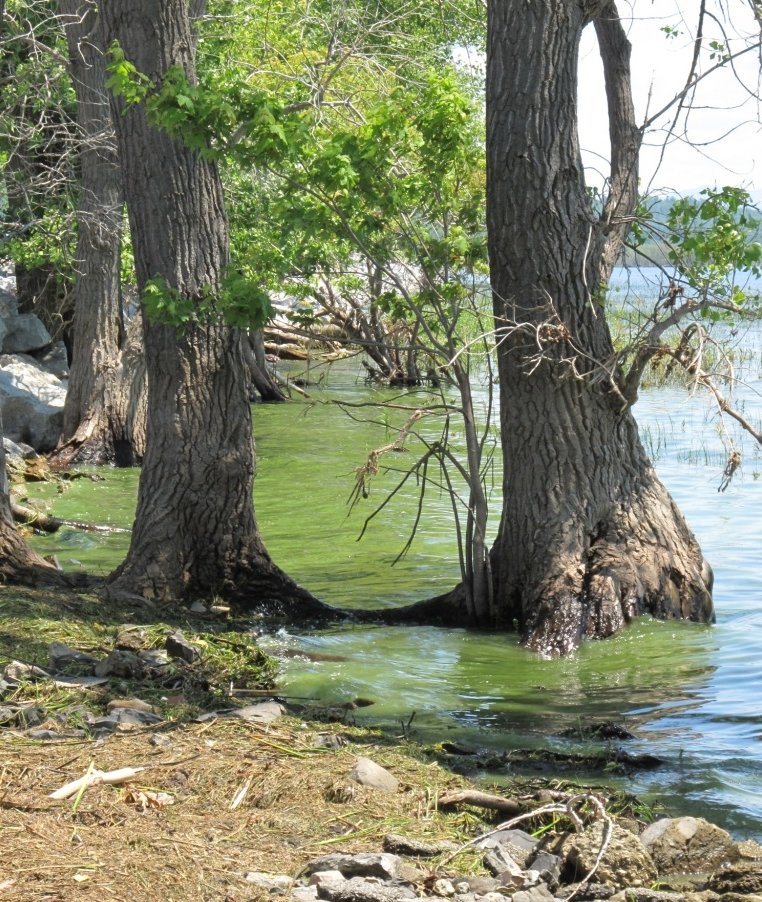Tips to identify and avoid harmful cyanobacteria or blue-green algae blooms
July 6, 2023 | By Waterbury Roundabout In this 2012 file photo, an algae bloom spreads along the shoreline east of North Beach in Burlington. Photo courtesy the Vermont health Department
With summer swimming season in full swing and beach closures already announced for locations along Lake Champlain, state health and environmental officials say it’s a good time to know what cyanobacteria blooms look like in order to avoid them.
Cyanobacteria blooms can be harmful to humans and pets. Also referred to as blue-green algae, cyanobacteria are tiny microorganisms that are a natural part of freshwater ecosystems. Under certain conditions, cyanobacteria multiply quickly, creating blooms on the water’s surface that can also wash up along shorelines. Blooms can produce toxins harmful to humans and animals.
“Take a quick scan of the water before you, your kids or your pets go in,” said Bridget O’Brien, an environmental health scientist with the Vermont Department of Health. “If you see any scummy or discolored water – or if you are unsure – play it safe and find another place.”
Swimming or wading in water with a cyanobacteria bloom may cause skin rashes, diarrhea, a sore throat, stomach problems, or more serious health concerns. Children and pets are most at risk. Children tend to play along the shore where cyanobacteria accumulate and may ingest water when they swim. And dogs may drink the water, lick bloom residue off their fur, and eat cyanobacteria scum from the shore.
“We can all safely enjoy Vermont’s lakes and ponds if we learn to recognize and avoid contact with cyanobacteria,” said Department of Environmental Conservation Commissioner John Beling. “If you think you see a bloom, be sure to report it.”
Vermonters can report cyanobacteria blooms using an online form that also allows for easy upload of photos. These reports are reviewed by staff from the Health Department, Lake Champlain Committee or Department of Environmental Conservation. Confirmed reports, along with location and any photos, are posted online on the Cyanobacteria Tracker site.
The Departments of Health and Environmental Conservation work closely with the Lake Champlain Committee to keep tabs on lakeshore conditions. For the past 20 years, the Lake Champlain Committee has trained community volunteers to monitor for cyanobacteria. These volunteer monitors, along with municipal recreational staff, as well as the Departments of Health and Environmental Conservation, provide data about where blooms are currently present, which get posted on the Health Department’s Cyanobacteria Tracker.
This 2011 Health Department file photo shows a blue-green algae or cyanobacteria bloom along the lake shoreline at Sandbar State Park.
Other photos online show green lake organisms that are not blue-green algae. Health Department file photo
Although the tracker notes the locations of recently reported blooms, O’Brien cautions Vermonters not to rely on the map alone. “Bloom conditions can and do change quickly, so it is still important to check the water when you get there. And be sure to pay attention to any posted signs warning of blooms or beach closures,” she said.
If you think you see a cyanobacteria bloom, avoid contact with the water and do not let pets or livestock swim in or drink the water. Also, state officials ask that you report the bloom. And if, despite your best efforts to avoid it you come in contact with cyanobacteria, health experts say to rinse off thoroughly as soon as possible and to talk with your healthcare provider.
Learn more
See a video of cyanobacteria and photos of what is – and isn’t – a bloom at HealthVermont.gov/cyanobacteria.
Find more information about cyanobacteria online at: the Vermont Department of Health, the Vermont Department of Environmental Conservation, and the Lake Champlain Committee.
To become a volunteer monitor, fill out the Lake Champlain Committee’s Cyanobacteria Monitor Interest Form.
For swim safety tips and more information about staying healthy while enjoying summer in Vermont: HealthVermont.gov/summer-safety-tips.



